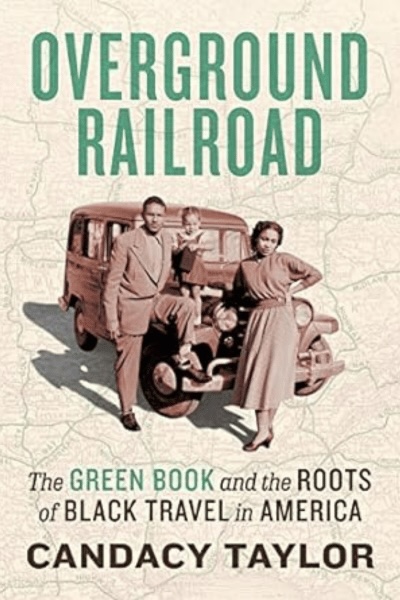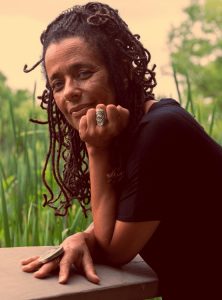 “Wonderful Wonderful Book Overground Railroad by Candacy Taylor is even of better use right now on where we as folk have been and how we moved and collected. Thank you Ms Taylor.” — Chuck D from Public Enemy
“Wonderful Wonderful Book Overground Railroad by Candacy Taylor is even of better use right now on where we as folk have been and how we moved and collected. Thank you Ms Taylor.” — Chuck D from Public Enemy
 “Candacy Taylor’s cleverly titled, heroically researched Green Book travelogue should be indispensable reading. The Underground Railroad carried tens of thousands of slaves to freedom. Taylor’s Overground Railroad transports their twentieth-century descendants to the Jim Crow reality of a hypocritical country. Her stunning book compels us to wonder where the ride is taking all of us now.” — David Levering Lewis, Pulitzer Prize for biography of W. E. B. Du Bois
“Candacy Taylor’s cleverly titled, heroically researched Green Book travelogue should be indispensable reading. The Underground Railroad carried tens of thousands of slaves to freedom. Taylor’s Overground Railroad transports their twentieth-century descendants to the Jim Crow reality of a hypocritical country. Her stunning book compels us to wonder where the ride is taking all of us now.” — David Levering Lewis, Pulitzer Prize for biography of W. E. B. Du Bois
 “The strength of this book about a book lies in the street-level views through which the American road unspools in all its compromised glory.” — The Economist
“The strength of this book about a book lies in the street-level views through which the American road unspools in all its compromised glory.” — The Economist
 “Thank you for making the invisible, visible.” — Gloria Steinem
“Thank you for making the invisible, visible.” — Gloria Steinem
 “Overground Railroad is an extraordinary reckoning with the America that whites have always believed existed, and with the America that blacks actually experienced, navigated, and made theirs despite every barrier.” — Heather Ann Thompson, Pulitzer Prize Winner for Blood in the Water: The Attica Prison Uprising of 1971
“Overground Railroad is an extraordinary reckoning with the America that whites have always believed existed, and with the America that blacks actually experienced, navigated, and made theirs despite every barrier.” — Heather Ann Thompson, Pulitzer Prize Winner for Blood in the Water: The Attica Prison Uprising of 1971
 “Candacy Taylor’s own quest for Green Book sites throughout the U.S. reveals her own relentlessness as well as a potent gift for bringing these sites, and the black past, alive.” — Henry Louis Gates Jr, Harvard University
“Candacy Taylor’s own quest for Green Book sites throughout the U.S. reveals her own relentlessness as well as a potent gift for bringing these sites, and the black past, alive.” — Henry Louis Gates Jr, Harvard University
 “In scope and tone, Overground Railroad recalls Isabel Wilkerson’s The Warmth of Other Suns…At its center, the book is a nuanced commentary of how black bodies have been monitored, censured or violated, and it compellingly pulls readers into the current news cycle.” — The Los Angeles Times
“In scope and tone, Overground Railroad recalls Isabel Wilkerson’s The Warmth of Other Suns…At its center, the book is a nuanced commentary of how black bodies have been monitored, censured or violated, and it compellingly pulls readers into the current news cycle.” — The Los Angeles Times
 “Candacy Taylor’s presentation is the best we’ve had in the 18 years we have been doing this lecture series.” — John Beck, Michigan State University
“Candacy Taylor’s presentation is the best we’ve had in the 18 years we have been doing this lecture series.” — John Beck, Michigan State University
 “…a fascinating history and sweeping story of black travel within Jim Crow America across four decades.” — The New York Times Book Review
“…a fascinating history and sweeping story of black travel within Jim Crow America across four decades.” — The New York Times Book Review
 “Taylor, previously a Harvard fellow, gives the topic the context and meticulous research it deserves while keeping an eye on current race relations.” — National Geographic
“Taylor, previously a Harvard fellow, gives the topic the context and meticulous research it deserves while keeping an eye on current race relations.” — National Geographic
 “With passion, conviction, and clarity, Taylor’s book unearths a fascinating and true—if not willfully obscured—history of African American activism and entrepreneurship in the United States. This remarkable study broadens our understanding of black life, leisure, and struggles for equality in twentieth-century America, presents the Green Book as a social movement in response to a crisis in black travel, and makes a compelling case for the need to protect more diverse African American sites that have been heretofore underappreciated.” — Brent Leggs, Executive Director of the African American Cultural Heritage Action Fund and senior vice president of the National Trust
“With passion, conviction, and clarity, Taylor’s book unearths a fascinating and true—if not willfully obscured—history of African American activism and entrepreneurship in the United States. This remarkable study broadens our understanding of black life, leisure, and struggles for equality in twentieth-century America, presents the Green Book as a social movement in response to a crisis in black travel, and makes a compelling case for the need to protect more diverse African American sites that have been heretofore underappreciated.” — Brent Leggs, Executive Director of the African American Cultural Heritage Action Fund and senior vice president of the National Trust
 “The National Highway Traffic Safety Administration is working to implement President Biden’s Executive Order on Advancing Racial Equity and Support for Underserved Communities Through the Federal Government, a key priority of the Biden-Harris Administration. Your presentation was so informative and impactful that it provided crucial context that will inform the work we do to implement this executive order and to better serve all people in this country through our safety mission.” — Steven S. Cliff, Ph.D. Deputy Administrator at the National Highway Traffic Safety Administration
“The National Highway Traffic Safety Administration is working to implement President Biden’s Executive Order on Advancing Racial Equity and Support for Underserved Communities Through the Federal Government, a key priority of the Biden-Harris Administration. Your presentation was so informative and impactful that it provided crucial context that will inform the work we do to implement this executive order and to better serve all people in this country through our safety mission.” — Steven S. Cliff, Ph.D. Deputy Administrator at the National Highway Traffic Safety Administration















